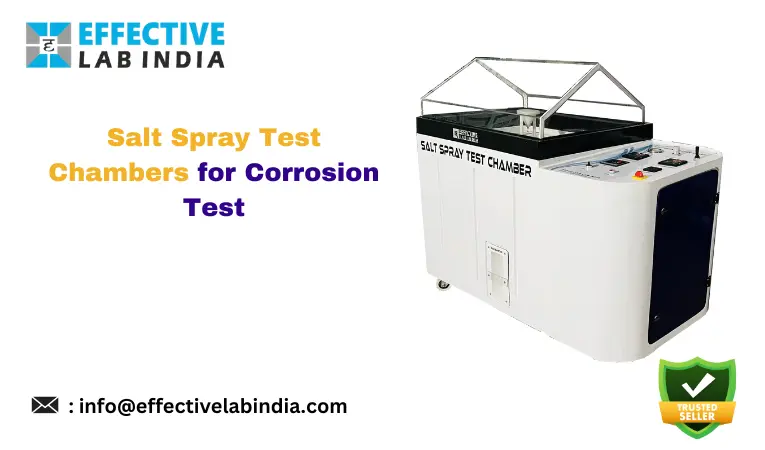One of the earliest techniques, developed at the start of the 20th century, is the salt spray test. In order to get relative corrosion resistance data for metal and coated metal exposed in a test chamber, a controlled corrosive environment is employed during the testing process. The salt spray chamber is the perfect tool for evaluating a material’s and surface coatings’ resistance to corrosion. The main purpose of the apparatus is to test paint and plating in order to confirm that coated samples are capable of withstanding corrosion or rust. The machine-tested materials have a metallic finish and a surface coating.
This effective testing method assesses whether a coating is suitable for use as a protective finish by subjecting coated samples to a corrosive attack. The predetermined time frame is used to evaluate the appearance of rust products.
The corrosion resistance of the coating determines how long the test will take. If testing is required for a longer time before corrosion appears on a coating with exceptional corrosion resistance. The salt spray test is a thorough and well-respected procedure. One general test for highly corrosive compounds is the salt spray test. There are several advantages to the test technique.
Applications of salt spray chamber
The salt spray chambers are employed in different number ways to test coated test specimens for resistance to rust. The coating is mostly used in the automotive industry because of its great corrosion resistance to ferrous alloys.
Aerospace: Aircraft, helicopters, space shuttles, and other aerospace vehicles are exposed to harsh environments, such as temperature fluctuations and vacuum states in space. The best places to test aerospace assemblies and parts to determine how resistant metallic components are to corrosion are test chambers.
Automobiles: There is a constant need for automotive parts and components, and suppliers and manufacturers must work hard to improve the quality of their output. One major problem is keeping automobile parts in good condition in severe environments. The test chambers offer an effective testing process for the end customers’ safe and comfortable use. Automotive parts must undergo corrosion testing; else, your car’s entire structure may deteriorate.
Electronic Components: To stop the dangerous condition, electronic components must be strong and of high quality. In an atmosphere high in salt, it is important to verify whether metallic electrical components or wires are resistant to corrosion.
Paint and Coating Test: This test chamber assesses the capacity of paints and coatings to withstand corrosion as well as their corrosion resistance. The test assessed paint and coating resistance to corrosive environments.
Hardware Tools: The tools are vulnerable to rust. The rusted instruments can inflict significant harm and should not be used.
Medical Equipment: Because it directly affects a person’s health, medical equipment needs to be dependable and long-lasting. The salt spray test must be used to assess this equipment’s corrosion resistance. It is unacceptable for medical equipment to corrode.
Railway: The corrosion resistance of the railway’s parts, rails, and other equipment must be inspected. Corrosion is the metallic surface’s deterioration or weakening.
Advantages of Salt Spray Chamber
- The salt spray test is done on a variety of materials since it can be done on painted or bare materials.
- In comparison to the natural setting, the exam is shorter. Standardized material is needed, and the cost is restricted.
- Additionally, a combined material and surface finish test is offered by the chamber. It is possible to test the assembled components and shaped objects, and the test findings are clear.
- The testing apparatus offers the precision and adaptability needed to satisfy the rigorous corrosion test methods of today.
- The device can produce air drying, high humidity, and salt spray inside the chamber at a specific temperature.
- A preset number of automatic repetitions of the corrosion cycle are possible.
Features of Salt Spray Chamber
- The HMI Touch Screen Panel in the salt spray test chamber allows for several modes of operation, such as program monitor, test mode, program profile, setting, history record, and ESC.
- The air saturator temperature ranges from 40 to 49 degrees Celsius, while the chamber temperature is kept between ambient and 35 degrees Celsius. The pH value is kept between 6.5 and 7.2.
- The range of air pressure is 0.7 kg/cm2 to 1.2 kg/cm2.
- The chamber features two walls made of fiber-reinforced plastic that are appropriately filled with glass wool insulation to prevent damage from the corrosive temperature that the room creates.
- The cabinet’s safety thermostat guards against overheating.
- To create fog inside the chamber, brine solution is utilized. The control panel’s adjustable control meter regulates the amount of salt fog.

